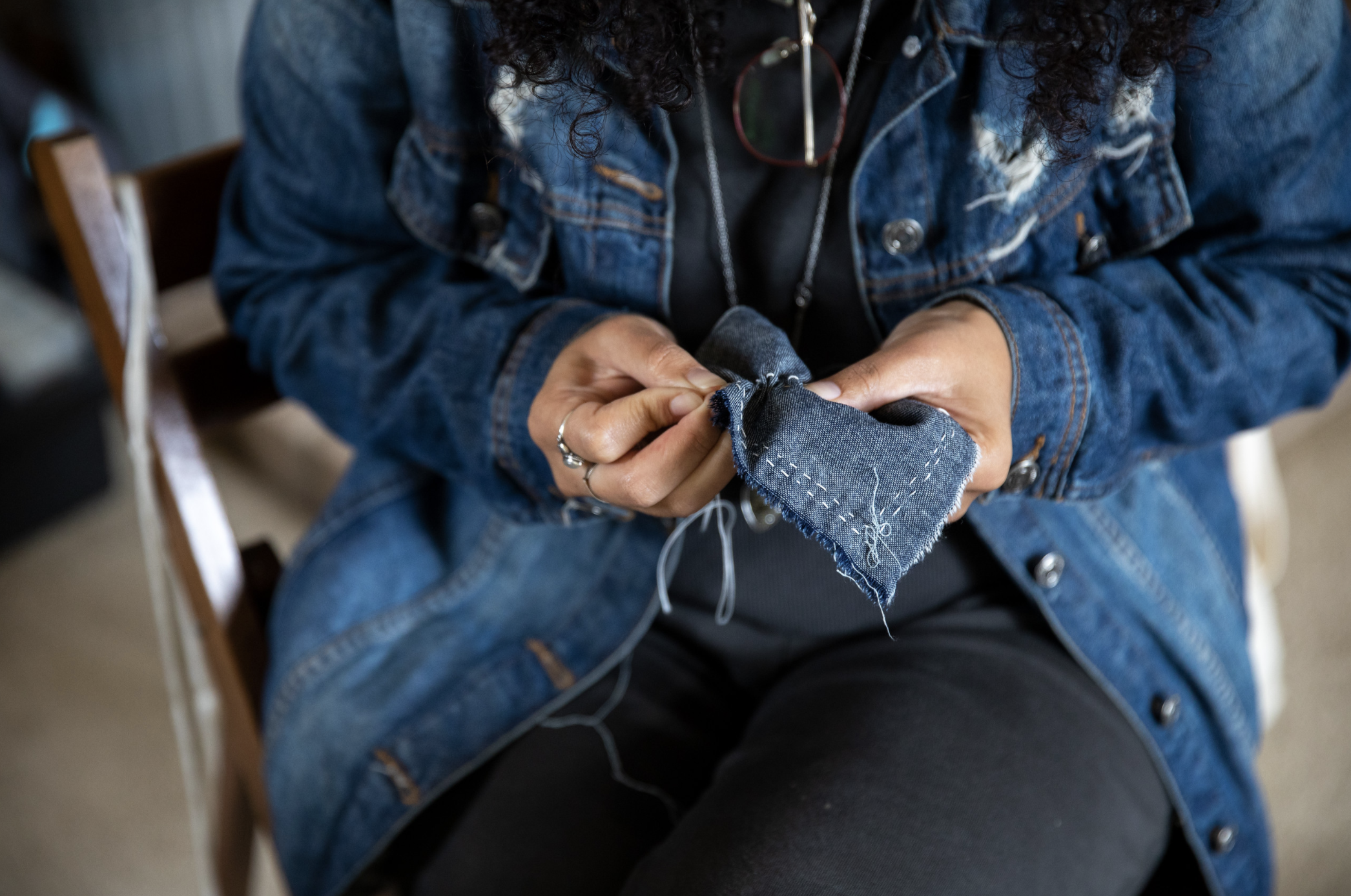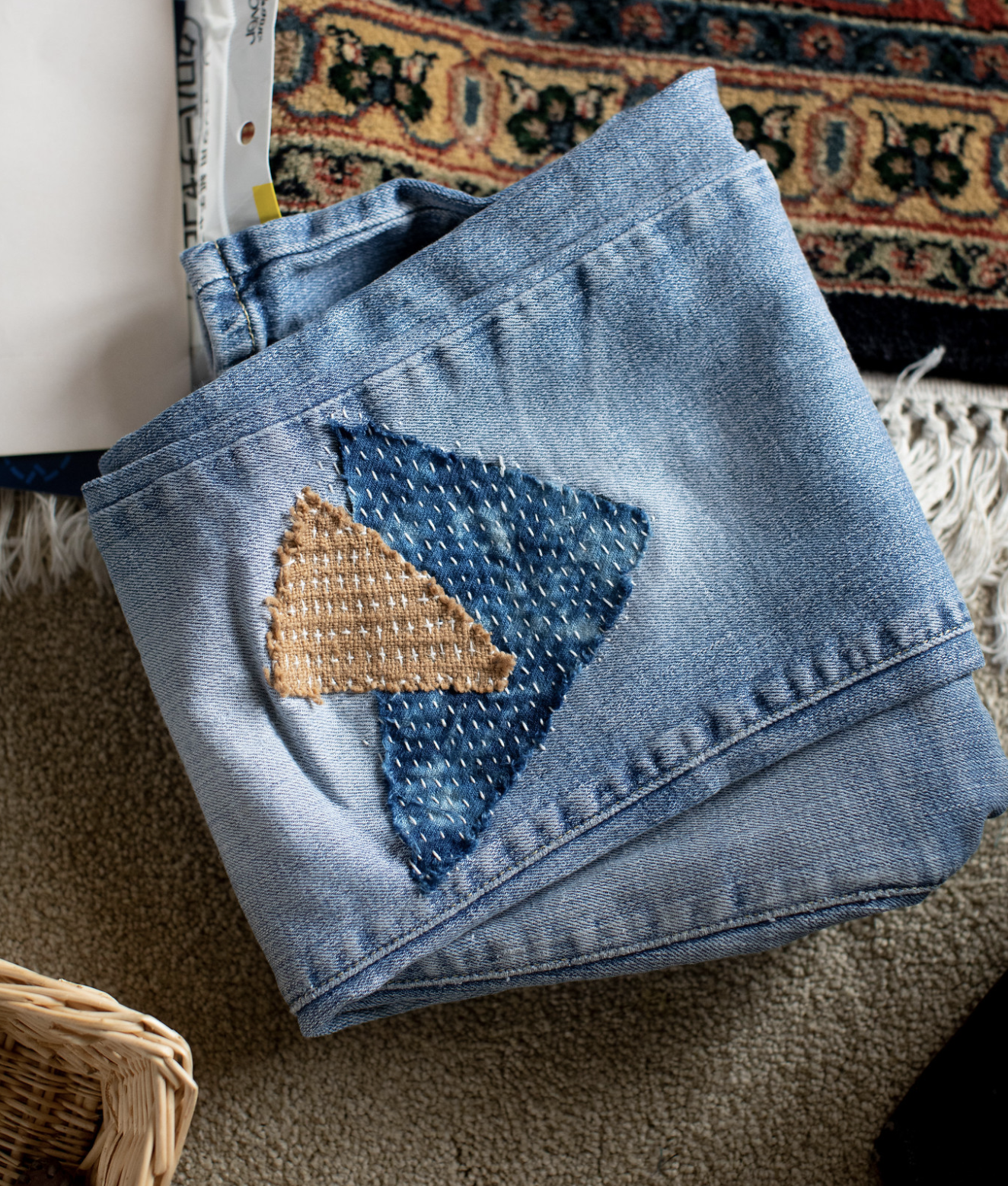
When was the last time you patched a shirt, darned a sock, or hemmed an ill-fitting pair of pants? Many of our ancestors were skilled in the arts of mending, repairing, sewing, knitting, cleaning, and generally repurposing their textiles to give them a longer life. Today, it’s all too easy to purchase something cheap and new. Many of us were never taught the skills that our forebears saw as essential.
But learning to mend clothes has personal, environmental, financial, and systemic benefits. Better yet, it’s approachable — anyone can learn how to mend on some level. But before we talk about how, let’s dig into why.
Resisting Destructive Systems
One logical outcome of learning how to mend your clothes is a decrease in how many garments you’re purchasing overall. That benefits you financially (more on that below), but it also means you’re divesting — at least in part — from the destructive fast fashion clothing and textile industries.
The money that flows into some of the most successful clothing companies on the planet is supporting practices that are incredibly harmful to workers, communities, and the environment. About 93% of apparel companies don’t pay workers a living wage, and many factory workers report dirty, dangerous working conditions. (You can listen to one skilled garment worker’s story in this conversation.) The fashion industry is also responsible for enormous amounts of pollution. A 2017 report estimated that the textile industry produces 1.2 billion tonnes of CO2 equivalent per year — more than international flights and maritime shipping combined. Worse still, the use of synthetic, plastic-based fibers in textiles has skyrocketed, turning many of our garments into environmental hazards from the day they’re born (and even before).

Truth be told, what we’re buying in textiles is only part of the problem. How much we’re buying is another huge issue.
The average consumer is buying 60% more garments today than they were 15 years ago, and the fashion industry doubled its clothing production in the past 20 years. Teju Adisa-Farrar wrote an article for Fibershed about a concept called “degrowth” that encourages us to scale down the global economy’s current rate of production to live within the ecological limits of our planet. In the article, she says:
“The driving force for this production model is to create infinite amounts of profit by producing as many things as possible for as cheaply as possible. This necessitates destroying the earth and simultaneously exploiting low-wage workers, who are mostly women of color. This belief in endlessly growing the economy is one of the main reasons why the fashion industry has to be completely transformed.”
When we mend, we’re able to prolong the life of our textiles, buy fewer items, and more easily remove our financial support from industries that don’t align with our values.
Saving Green
In a 2015 Forbes article, Emma Johnson reported:
“The U.S. apparel industry today is a $12 billion business and the average American family spends $1,700 on clothes annually, according to the Bureau of Labor Statistics… What is significant is whether that money is spent on need or waste. The answer is, largely, waste. In 1930, the average American woman owned nine outfits. Today, that figure is 30 outfits — one for every day of the month.”
Over time, consumers are spending more money to own more garments, many of which will quickly end up in the landfill — or worse (more on that below). We’re throwing our money away rather than purchasing high-quality, natural-fiber garments that we’ll cherish and take care of for years. There’s even a whole world of Climate Beneficial™ Fiber, which is generally long-lasting, easy to wash, and grown and raised in ways that maximize the drawdown of carbon from the atmosphere to help restore ecosystem health and stabilize our climate.

By learning to mend our textiles, we can hold onto them for longer, halting the costly clothing cycle in which we’ve been trapped. Your investment in higher quality clothing can hold its value, while supporting production that has better impacts on people and the planet.
Waste Not
According to CalRecycle, textiles are the fifth most common material in residential and commercial waste streams. California families send more than 1.2 million tons of textiles to landfills, accounting for 6% of the total waste stream. In the U.S., a total of 25 billion pounds of clothing is discarded every year. That’s 82 pounds a year for every U.S. resident.
The majority of textiles manufactured today make use of synthetic (plastic) fibers, mainly petroleum-derived polyester, and if we continue with the current economic and regulatory incentives, these fibers will be even more prevalent in the future. In landfills, synthetic fibers can take hundreds of years to decompose. Throughout their lifespan, synthetic textiles release harmful microplastics and toxins into the air, water, soil, and our surrounding environment.

Many of the garments we donate, return, or “recycle,” get shipped overseas to communities where this waste stream creates social and environmental damage. For example, more than 15 million ‘donated’ garments arrive every week to the port in Accra, Ghana — a region of only 4 million people. Without infrastructure or capacity to handle this influx of waste from other regions, most of the items transported there end up in landfills, roadsides, or directly in the ocean, creating a devastating amount of pollution.
Mending inevitably leads to less waste. Our items that might have been thrown away can have second, third, and fourth lives, easing the strain on our waste streams and preventing our waste from becoming a burden to other communities.
Empowerment & Mindfulness
While learning to keep our textiles in use for longer is good for people and ecosystems throughout the world, we’re also drawn to the personal benefits of a regular mending practice. Learning a new skill, especially one that makes us more self-sufficient and less reliant on harmful systems, is empowering. Mending gives us the peace of mind of knowing that when a garment shows signs of wear, we’re not required to spend time finding something new and then spend money on that new thing. We have what we need, in our homes and in our heads, to get by.
Moreover, mending is a practice in mindfulness. Stitching and mending textiles is calming, meditative, and tactile. It brings you closer to the items on which you rely, and it pushes you to appreciate your garments more intensely. When we wear and use textiles that we value and that we feel good about, our perspective on ourselves and the world around us changes for the better.
Ready to Mend?
Growing your mending skillset is a great way to reduce your fiber system footprint. Wherever you live, you may be able to find classes via your local arts center, sewing and fabric stores, and crafting communities. You may also be able to find online classes.

Fibershed also provides in-person resources for textile learners in Northern California. In our monthly Mending Bar Happy Hours, you can learn from local mending experts, Heidi Iverson of Honey Folk Clothing and Allison Reilly, how to visibly mend with thread and patching, along with learning how to mend your wovens, developing your own stitch patterns. You will be fusing fabrics together with stitch, so they become a new cloth! You will have the option of practicing boro, sashiko, darning, & quilting techniques on a sampler first, or you can jump right in and start on the item you brought to repair.
Our Mending Bar Happy Hours will take place at our Fibershed Learning Center in Point Reyes Station on the fourth Thursday of every month from 4-7 p.m. Donation-based and registration is required.
We will also be hosting in-person weekend workshops, along with virtual mending classes, so stay tuned!
Want to Learn More About Mending?
Listen to episode 11 of our Soil to Soil Podcast: Can mending create a cultural shift? with Sonya and Nina Montenegro of The Far Woods. In this episode, we explore how we can tend to our clothing, and how repairing, patching, and mending our clothing can be part of a cultural shift that values the people who labored to bring our clothes into being, and reduces the impact of textile waste on the environment.
